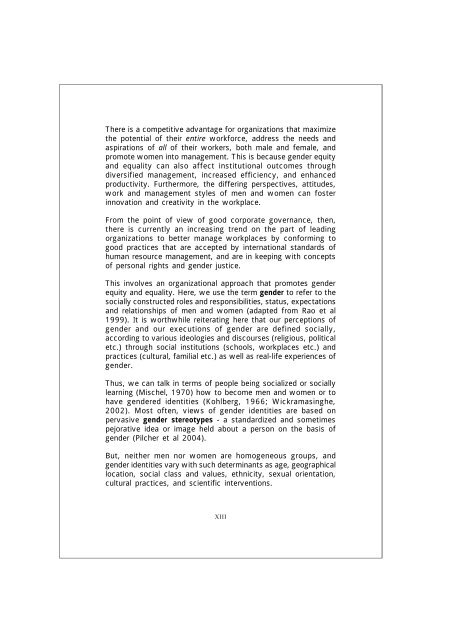Beyond Glass Ceilings and Brick Walls - International Labour ...
Beyond Glass Ceilings and Brick Walls - International Labour ...
Beyond Glass Ceilings and Brick Walls - International Labour ...
Create successful ePaper yourself
Turn your PDF publications into a flip-book with our unique Google optimized e-Paper software.
There is a competitive advantage for organizations that maximize<br />
the potential of their entire workforce, address the needs <strong>and</strong><br />
aspirations of all of their workers, both male <strong>and</strong> female, <strong>and</strong><br />
promote women into management. This is because gender equity<br />
<strong>and</strong> equality can also affect institutional outcomes through<br />
diversified management, increased efficiency, <strong>and</strong> enhanced<br />
productivity. Furthermore, the differing perspectives, attitudes,<br />
work <strong>and</strong> management styles of men <strong>and</strong> women can foster<br />
innovation <strong>and</strong> creativity in the workplace.<br />
From the point of view of good corporate governance, then,<br />
there is currently an increasing trend on the part of leading<br />
organizations to better manage workplaces by conforming to<br />
good practices that are accepted by international st<strong>and</strong>ards of<br />
human resource management, <strong>and</strong> are in keeping with concepts<br />
of personal rights <strong>and</strong> gender justice.<br />
This involves an organizational approach that promotes gender<br />
equity <strong>and</strong> equality. Here, we use the term gender to refer to the<br />
socially constructed roles <strong>and</strong> responsibilities, status, expectations<br />
<strong>and</strong> relationships of men <strong>and</strong> women (adapted from Rao et al<br />
1999). It is worthwhile reiterating here that our perceptions of<br />
gender <strong>and</strong> our executions of gender are defined socially,<br />
according to various ideologies <strong>and</strong> discourses (religious, political<br />
etc.) through social institutions (schools, workplaces etc.) <strong>and</strong><br />
practices (cultural, familial etc.) as well as real-life experiences of<br />
gender.<br />
Thus, we can talk in terms of people being socialized or socially<br />
learning (Mischel, 1970) how to become men <strong>and</strong> women or to<br />
have gendered identities (Kohlberg, 1966; Wickramasinghe,<br />
2002). Most often, views of gender identities are based on<br />
pervasive gender stereotypes - a st<strong>and</strong>ardized <strong>and</strong> sometimes<br />
pejorative idea or image held about a person on the basis of<br />
gender (Pilcher et al 2004).<br />
But, neither men nor women are homogeneous groups, <strong>and</strong><br />
gender identities vary with such determinants as age, geographical<br />
location, social class <strong>and</strong> values, ethnicity, sexual orientation,<br />
cultural practices, <strong>and</strong> scientific interventions.<br />
XIII
















